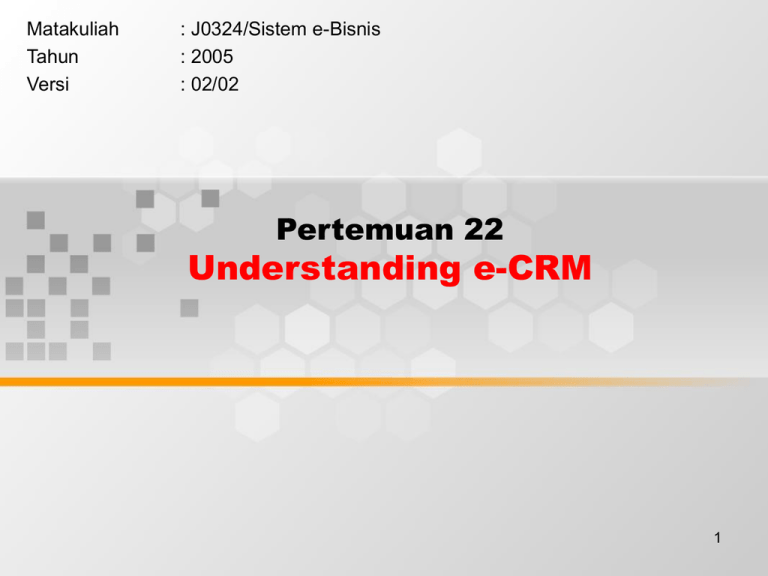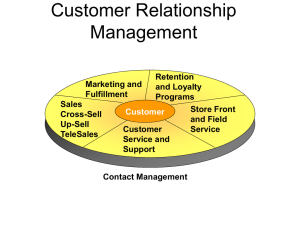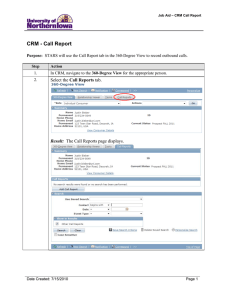Understanding e-CRM Pertemuan 22 Matakuliah : J0324/Sistem e-Bisnis
advertisement

Matakuliah Tahun Versi : J0324/Sistem e-Bisnis : 2005 : 02/02 Pertemuan 22 Understanding e-CRM 1 Learning Outcomes Pada akhir pertemuan ini, diharapkan mahasiswa akan mampu : • menunjukkan strategi penerapan e-CRM 2 Outline Materi • • • • The Basics of e-CRM E-CRM Apllication and Tools Benefits and Limitation of e-CRM Next-Generation of CRM Trends 3 CRM Applications and Tools: Delivering Customer Service in Cyberspace • CRM applications improve upon traditional customer service by means of easier communications and speedier resolution of customer problems • Customer service adds value to products and services • It is an integral part of a successful business 4 CRM Applications and Tools (cont.) • Classifications of CRM applications – Customer-facing applications – Customer-touching applications – Customer-centric intelligence applications – Online networking and other applications 5 CRM Applications and Tools (cont.) • Customer-facing applications Customer interaction center (CIC): A comprehensive service entity in which EC vendors address customer service issues communicated through various contact channels • Intelligent agents in customer service and call centers 6 CRM Applications and Tools (cont.) 7 CRM Applications and Tools (cont.) 8 CRM Applications and Tools (cont.) • Autoresponders: Automated e-mail reply systems (text files returned via e-mail), which provide answers to commonly asked questions • Sales force automation (SFA): Software that automates the tasks performed by sales people in the field, such as data collection and its transmission 9 CRM Applications and Tools (cont.) • Customer-touching applications – Personalized Web Pages – E-Commerce Applications – Campaign Management 10 CRM Applications and Tools (cont.) – Web Self-Service Activities conducted by users on the Web to provide answers to their questions (e.g., tracking) or for product configuration • Self-tracking • Self-configuration and customization 11 CRM Applications and Tools (cont.) • Customer-centric applications – Data reports – Data warehouse A single, server-based data repository that allows centralized analysis, security, and control over the data 12 CRM Applications and Tools (cont.) • Data analysis and mining – Analytic applications automate the processing and analysis of CRM data can be used to analyze the performance, efficiency, and effectiveness of an operation’s CRM applications – Data mining involves sifting through an immense amount of data to discover previously unknown patterns 13 CRM Applications and Tools (cont.) • Online networking and other applications – Forums – Chat rooms – Usenet groups – E-mail newsletters – Discussion lists 14 CRM Applications and Tools (cont.) • Mobile CRM the delivery of CRM applications to any user, whenever and wherever needed • Voice communication people are more comfortable talking with a person, even a virtual one, than they are interacting with machines. The smile and the clear pronunciation of the agent’s voice increases shoppers’ confidence and trust 15 CRM Applications and Tools (cont.) 16 CRM Applications and Tools (cont.) • Role of knowledge management and intelligent agents in CRM – Automating inquiry routing and answering queries requires knowledge – Generated from historical data and from human expertise and stored in knowledge bases for use whenever needed – Intelligent agents support the mechanics of inquiry routing, autoresponders, and so on 17 • Source : Turban, Efraim, David King, Jae Lee and Dennis Viehland. Electronic Commerce. A Managerial Perspective (2004). Prentice Hall. PPT for Chapter : 4 18




